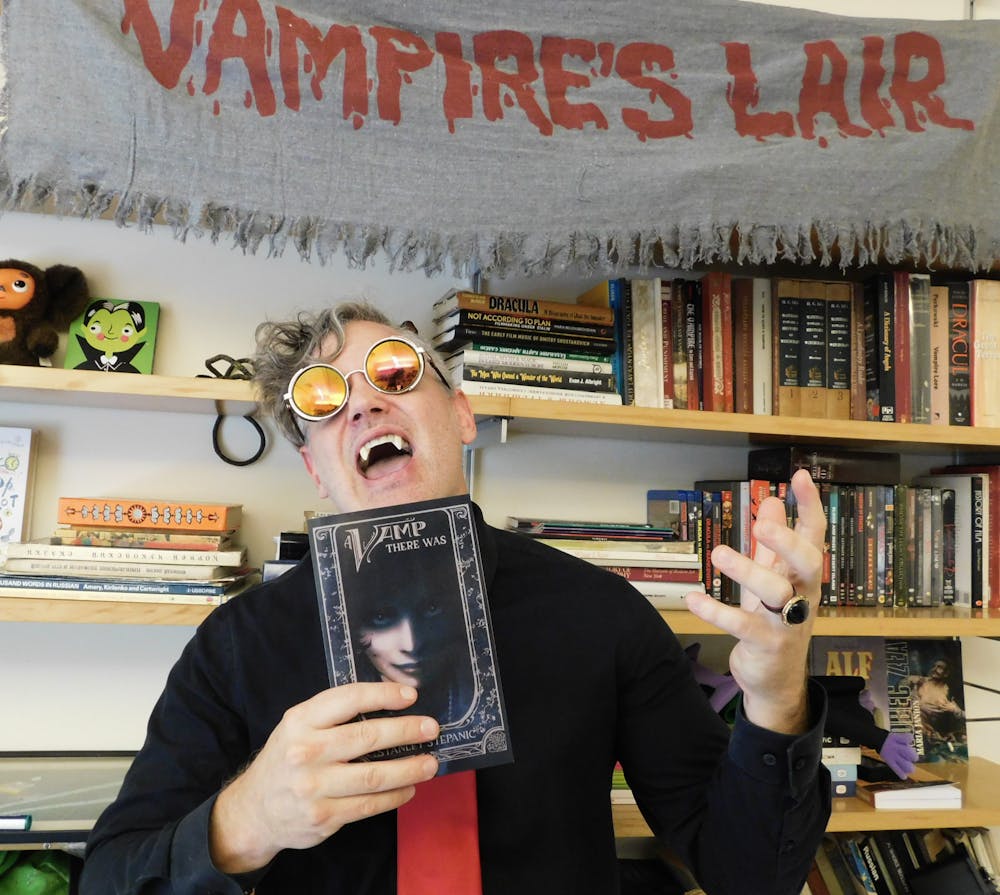When students enter Asst. Prof. Stanley Stepanic’s office, they are met with a spooky sight. An inflatable bat dangles off a shelf over the computer, a puppet Count von Count from “Sesame Street” rests on top of a pile of Polish books and posters advertising “Buffy the Vampire Slayer” and “Love Me Deadly” hang next to a marker rendering of Dracula — Stepanic’s office is a tribute to the supernatural being at the center of his new novella, “A Vamp There Was.”
Stepanic is part of the University’s Slavic Languages and Literatures department. He teaches a popular class on Dracula which covers the history of the vampire from pre-Christian Slavic belief to the present and often pops up on lists of students’ favorite University courses. According to Stepanic, scholarship on vampires is valuable because analysis of vampire folklore provides insight into humanity.
“Vampires, over time, have become symbolic of human experience,” Stepanic said. “They reflect the times they exist in and the people that create them.”
Now, he’s one of those people — his novella titled “A Vamp There Was” was released Sept. 3. The book is Stepanic’s first fiction publication, but it is not entirely invented — his vampire story is supplemented by metatextual references to the historical context of its setting and the literary tropes it employs.
While Stepanic is recognized as a vampire expert — he gets lots of media requests around Halloween — he originally came to the University in 2005 for postgraduate studies with a plan to focus on Russian language. Stepanic also worked as a teaching assistant for Prof. Jan Perkowski’s class on Dracula for a couple of years, launching his love for the topic. After Prof. Perkowski retired, Stepanic got the opportunity to retool the curriculum and teach the class himself.
The course has exploded in popularity over time — the 35-person section Perkowski passed on to Stepanic is now the iconic 200-person SLAV 2360. Stepanic said his focus on links between vampires and the human realities they represent helps “Dracula” stand out to students.
“The thing about the class I think is interesting, and students think is interesting after they take it and understand it, is that … it's really a class about human beings,” Stepanic said. “Students learn about anthropology and linguistics and language and disease epidemics and racial identity and gender identity, practically anything you can think about that relates to human beings relates to a vampire in some way.”
Similar to the societal perspective on vampire folklore which defines his “Dracula” course, Stepanic said he found inspiration for “A Vamp There Was” in something human — a photograph of a Fredericksburg woman shot in the heart by her husband in 1934 for infidelity. He said he first imagined an epic sci-fi romance based on his research into the case — the story of a man who falls in love with a woman in a photograph and time-travels to the past to be with her. However, agents he approached were not interested in the project.
Then, in 2013, he came up with a new idea informed by “Dracula” class content on the vamp archetype — that of an irresistible woman who deploys her wiles to manipulate men, named for the vampire played by Theda Bara in “A Fool There Was” but applied to mortal women of this era too.
“Since I'd already done so much research into Fredericksburg at that time, and knew what the city layout was like and stuff like that, I was like, what if I took that vamp thing and made it an actual vampire — took that classic flapper image of the vamp and made it an actual supernatural being,” Stepanic said.
Stepanic’s vamp transfixes a young boy from Fredericksburg who investigates the secrets of her past and her devastating effect on the men who fall for her. This fictional story is complemented by fact — “A Vamp There Was” is an annotated text, complete with endnotes explaining links to local history and gothic epistolary forms, an essay on the development of the vamp as a trope and a catalog of actors who played vamps and the films in which they played them.
“I [wanted] to write my own history based on what I learned,” Stepanic said. “I went through all these digital archives. You can go through old magazines and books and find this stuff so much more easily than you would have before the internet.”
The combination of imagination and meticulous research found in “A Vamp There Was” reflects Stepanic’s anthropological approach to his “Dracula” class. While his text references representations of the vampire popular in the past, “A Vamp There Was” points to societal influences on vampire folklore which offer insight into new iterations of the creature that proliferate today.
“A Vamp There Was” is available online now, or readers can pick up a copy at Stepanic’s upcoming book talk and signing Oct. 19 at New Dominion Bookshop.







